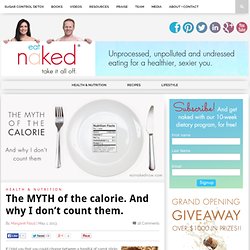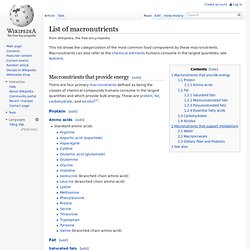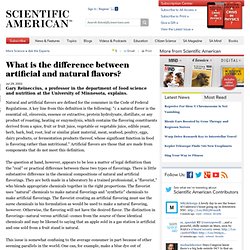

Dear Mark: Salt and Blood Pressure. Welcome!

If you want to lose weight, gain muscle, increase energy levels or just generally look and feel healthier you've come to the right place. Here's where to start: Visit the Start Here and Primal Blueprint 101 pages to learn more about the Primal Lifestyle. Ames Test - Carcinogens and Natural foods. Cholesterol and Your Mood - Cholesterol. DIAAS Scores. Eat Naked Now » Blog Archive » The MYTH of the calorie. And why I don’t count them. + Margaret Floyd, NTP + Nutrition + Wellness + Los Angeles.
If I told you that you could choose between a handful of carrot sticks and two non-fat chocolate chip cookies, that each has the same number of calories and would have the exact same impact on your waistline, which would you choose?

C’mon, be honest. We’d all pick the cookies. And if we listened to a lot of the messages out there about weight, then that would be the logical choice. After all, isn’t it all about calories-in calories-out, regardless of where those calories came from? Eat Naked Now » Blog Archive » The Fat Question: Why fat doesn’t make you fat + Margaret Floyd, NTP + Nutrition + Wellness + Los Angeles.
List of macronutrients. This list shows the categorization of the most common food components by these macronutrients.

Macronutrients can also refer to the chemical elements humans consume in the largest quantities, see Nutrient. Macronutrients that provide energy[edit] Protein[edit] Amino acids[edit] Fat[edit] Saturated fats[edit] Monounsaturated fats[edit] Polyunsaturated fats[edit] Essential fatty acids[edit] These 2 essential fatty acids are the starting point for other important omega-acids (e.g. Top 10 Foods Highest in Fiber. Dietary fiber (dietary fibre, roughage) is an essential nutrient required for proper digestion of foods, proper functioning of the digestive tract at large, and for helping you feel full.

A deficiency of fiber can lead to constipation, hemorrhoids, and elevated levels of cholesterol and sugar in the blood. Conversely, an excess of fiber can lead to a bowel obstruction, diarrhea, or even dehydration. Individuals who increase their intake of fiber, should in turn, also increase their intake for water. The current DV for dietary fiber is 25 grams. Below is a list of high fiber foods, for more, see the extended lists of high fiber foods by nutrient density, fiber rich foods, fruits high in fiber, and grains high in fiber. List of micronutrients. Micronutrients for good health. Nutritionist Lisa Guy decodes the two most basic nutrient groups.

The foods we eat provide our body with the raw materials it needs for growth, development and function. There are two basic groups of nutrients that must be obtained through the diet: macro-nutrients and micro-nutrients. Macro-nutrients are comprise of proteins, carbohydrates and unsaturated fats while vitamins and minerals make-up micro-nutrients. All nutrients play different but vital roles in our health and wellbeing. How to include more micro-nutrients in your diet Although needed only in small amounts, micro-nutrients are essential for the proper functioning of every system in the body and are vital for good health. High alpha-carotene levels associated with longer life. High blood levels of the antioxidant alpha-carotene appear to be associated with a reduced risk of dying over a 14-year period, according to a report posted online November 22 that will be published in the March 28 print issue of Archives of Internal Medicine.

Oxygen-related damage to DNA, proteins and fats may play a role in the development of chronic diseases like heart disease and cancer, according to background information in the article. Carotenoids -- including beta-carotene, alpha-carotene and lycopene -- are produced by plants and microorganisms and act as antioxidants, counteracting this damage. Carotenoids in the human body are obtained mainly through eating fruits and vegetables rich in the nutrients, or through antioxidant supplements. Although studies suggest eating more fruits and vegetables is associated with lower risk of chronic diseases, randomized controlled trials have not shown any benefit for beta-carotene supplements, the authors note. Scott Abel - The Blog: The Branch Chain Amino Acids (BCAAs): Save your Money!
Understanding “Riding the Research” I think people forget my decades of work behind the scenes in the fitness and supplement industry.

In those decades up to now what has puzzled me most is not the level of flat out fraud in the supplement industry; but the fact that so few people catch on to it in the modern digital age. I would love to do a whole expose and will give you some ideas below as to how all this nonsense works to market supplements to you that you don’t need. What is the difference between artificial and natural flavors? Gary Reineccius, a professor in the department of food science and nutrition at the University of Minnesota, explains.

Borge Fagerli – aka Blade: My blog and coaching services. A normal contest prep for a male bodybuilder is usually in the 10-12 week range – but if you stay lean year-round (something I recommend) you can probably get away with half that.

It doesn’t need to be all that complicated. Drop carbs, up the protein and add some daily treadmill or stepmill sessions of 30-60mins. Throw some fat burners in the mix. Rinse and repeat until lean. WBFF Bikini Pro Laura Michelle Prestin Talks Simplyshredded.com [Updated 2012] Quick stats Location: Canada Age: 27 Height: 5’7″ Weight: 125 lbs.
![WBFF Bikini Pro Laura Michelle Prestin Talks Simplyshredded.com [Updated 2012]](http://cdn.pearltrees.com/s/pic/th/michelle-simplyshredded-67446838)
When did you get started with fitness? I have always been physically active since I was 7 years old and I played competitive soccer, and ran OFFSA cross country and track during my younger years. I also was a swimmer, and at one point in gymnastics for a little bit. 14 Best Diets for 2013: See What Topped Weight Watchers. Body Transformation: Jen Jewell's Road To Pro. Ames test. The Ames test is a widely employed method that uses bacteria to test whether a given chemical can cause cancer. More formally, it is a biological assay to assess the mutagenic potential of chemical compounds.[1] A positive test indicates that the chemical is mutagenic and therefore may act as a carcinogen, because cancer is often linked to mutation. The test serves as a quick and convenient assay to estimate the carcinogenic potential of a compound because standard carcinogen assays on mice and rats are time-consuming (taking two to three years to complete) and expensive.
However, false-positives and false-negatives are known.[2] The procedure was described in a series of papers in the early 1970s by Bruce Ames and his group at the University of California, Berkeley.[3][4][5][6] General procedure[edit] Latest Cochrane review on dietary fats and cardiovascular disease. Right on the heels of the updated Cochrane review on “Reduced dietary salt for the prevention of cardiovascular disease,” (and the terrible reporting on it), another one is updated: “Reduced or modified dietary fat for preventing cardiovascular disease.” One of the authors (Lee Hooper) worked on the salt review as well.
Given that this is a Cochrane review, it uses only RCTs (and only studies that tracked morbidity and mortality, not just intermediate risk factors). Of course as always, the caveats of basing overall conclusions on topics only on RCTs should be noted, but given that this issue has so much data from different study designs, I was curious if the conclusions from the new Cochrane would match recent publications: Note: If you want a short summary directly from Lee Hooper, the Cochrane site has a short podcast here. Redirect Notice. The free encyclopedia. Low-carbohydrate diet. Such diets are sometimes 'ketogenic' (i.e., they restrict carbohydrate intake sufficiently to cause ketosis). The induction phase of the Atkins diet[1][2][3] is ketogenic.
The term "low-carbohydrate diet" is generally applied to diets that restrict carbohydrates to less than 20% of caloric intake, but can also refer to diets that simply restrict or limit carbohydrates to less than recommended proportions (generally less than 45% of total energy coming from carbohydrates).[4][5] Low-carbohydrate diets are used to treat or prevent some chronic diseases and conditions, including cardiovascular disease, metabolic syndrome, high blood pressure, and diabetes.[6][7] History[edit] Prehistory[edit] Paleolithic diet. A dish fitting the Paleolithic diet: Brazilian bouillabaisse (seafood stew) The paleolithic diet is a modern nutritional plan based on the presumed diet of Paleolithic humans. It is based on several controversial premises, the most important of which are: first, that human genetics have scarcely changed since the dawn of agriculture, which marked the end of the Paleolithic era, around 15,000 years ago; second, that modern humans are adapted to the diet or diets of the Paleolithic period; and, third, that it is possible for modern science to discern what such diets consisted of.
The Paleolithic diet consists mainly of fish, grass-fed pasture raised meats, eggs, vegetables, fruit, fungi, roots, and nuts, and excludes what are perceived to be agricultural products; grains, legumes, dairy products, potatoes, refined salt, refined sugar, and processed oils. Certain portions should be established for balance of nutrients to maintain homeostasis.[1][2] History[edit] Saturated fat and cardiovascular disease controversy. Ketogenic diet. This article is about a dietary therapy for epilepsy. For information on ketogenic low-carbohydrate diets as a lifestyle choice or for weight loss, see Low-carbohydrate diet.
The ketogenic diet is a high-fat, adequate-protein, low-carbohydrate diet that in medicine is used primarily to treat difficult-to-control (refractory) epilepsy in children. The diet forces the body to burn fats rather than carbohydrates. Normally, the carbohydrates contained in food are converted into glucose, which is then transported around the body and is particularly important in fuelling brain function. Medical research related to low-carbohydrate diets. Low-carbohydrate diets became a major weight loss and health maintenance trend during the late 1990s and early 2000s.[1][2][3] While their popularity has waned recently from its peak, they remain popular.[4][5] This diet trend has stirred major controversies in the medical and nutritional sciences communities and, as yet, there is not a general consensus on their efficacy or safety.[6][7] As of 2008 the majority of the medical community remains generally opposed to these diets for long term health[8][9][10] although there has been a recent softening of this opposition by some organizations.[11][12]
Non-Celiac Gluten Sensitivity Research. Research into non-celiac gluten sensitivity — also known as gluten intolerance — increasingly is proving that you can get serious symptoms from gluten ingestion without having celiac disease. In a landmark study on gluten sensitivity released in early 2011, prominent celiac researcher Dr. Gluten Sensitivity Diagnosis Method Proposed By Group of Experts. Why A High-Fat Diet is Healthy and Safe. Welcome! If you want to lose weight, gain muscle, increase energy levels or just generally look and feel healthier you've come to the right place. Why A High-Fat Diet is Healthy and Safe. Pass the Protein, Please! Are saturated fats actually bad for you? - Men's Health Magazine. By Nina Teicholz Suppose you were forced to live on a diet of red meat and full-cream milk.
A diet that, all told, was at least 60 per cent fat - about half of it saturated.